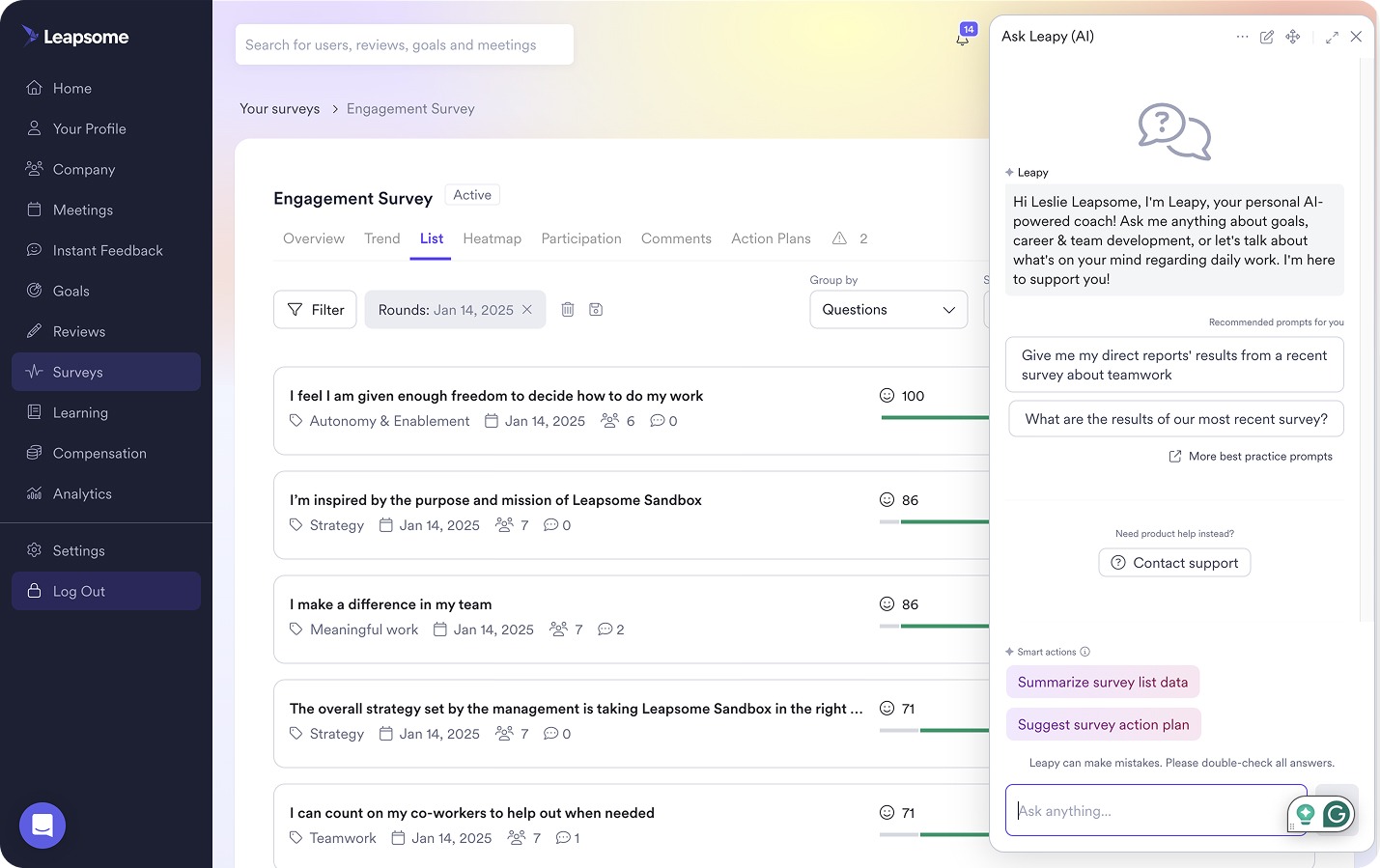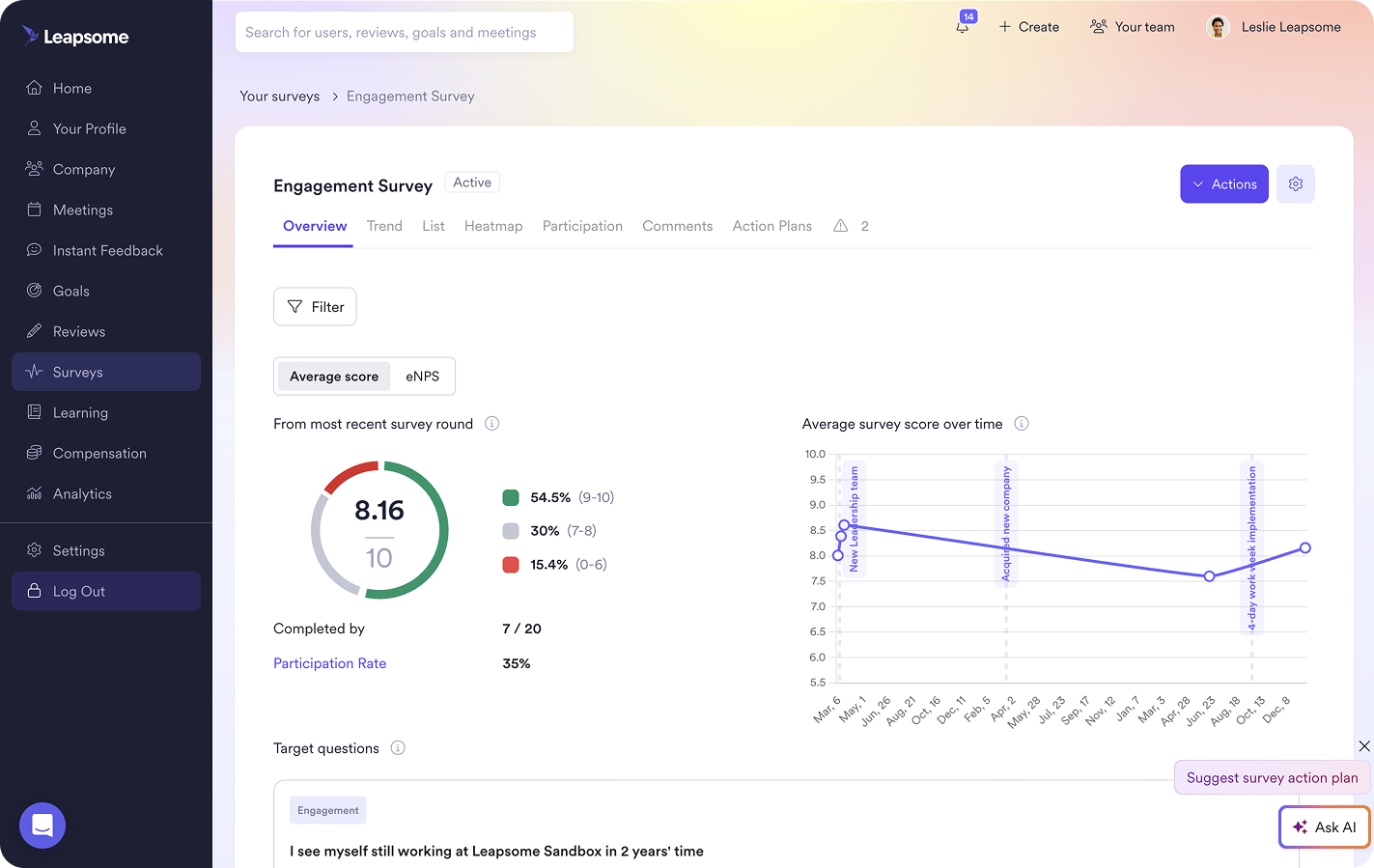Free employee satisfaction survey template (+ customization tips)

Get this free employee satisfaction survey template with 20+ proven questions organized by key themes like leadership, compensation, and communication. Use it to capture honest feedback and identify exactly where to focus your improvement efforts.
Most organizations are dealing with constant change and unclear expectations. With 73% of organizations experiencing disruptive change and only 45% of employees having clear role expectations, structured feedback collection has become essential. This template gives you ready-to-use questions plus practical guidance on customizing surveys for your team size and priorities
Create smarter employee satisfaction surveys
Build customizable satisfaction surveys with conditional logic, automated insights, and action tracking that turns feedback into measurable improvements.
👉 Try Leapsome's survey builder
*Both stats from Gallup, 2025
What's inside the template
This survey uses a simple Likert scale format (1-5) with a few open-ended questions to capture both quantitative scores and qualitative insights. We've organized questions under 8 key themes that matter most to employee satisfaction:
- Culture & belonging — How connected employees feel to your organization and values
- Leadership & management — Trust in leadership and management effectiveness
- Compensation & benefits — Fair pay and meaningful benefits packages
- Communication — Clarity of expectations and information flow
- Career development — Growth opportunities and learning access
- Recognition — Appreciation for contributions and good work
- Workload & well-being — Manageable responsibilities and work-life balance
- Work environment — Physical workspace and available resources
Each theme includes 2-3 targeted questions that help you pinpoint specific areas for improvement. For example, under communication, you'll find "My manager communicates expectations clearly" and "I feel informed about important company updates" — giving you actionable insights into where communication gaps might exist.
While this template focuses on satisfaction, our employee engagement survey questions guide offers additional question ideas that measure engagement specifically.
Get your ready-to-use employee satisfaction survey template
Need a quick way to gauge how your employees are feeling? Download this survey template.

📥 Download the free employee satisfaction survey template
Use this template to get actionable insights from your team.
Get the free template
Turn employee feedback into action
Schedule surveys through the platform, streamline distribution with automation, and leverage AI to capture insights that drive real organizational change.
👉 Explore Leapsome Surveys
Tips for customizing the template
Your organization is unique, so your survey should be too. Here's how to adapt this template to fit your specific needs and priorities.
Here's how this template would work in Leapsome Surveys: Instead of managing static documents, you'd set up this exact question structure in the platform.
Each category becomes a separate section with built-in analytics. When you publish the survey, Leapsome automatically calculates category scores, identifies your lowest-performing areas, and even suggests follow-up questions based on response patterns.
For example, if 'Leadership' scores below 3.5, the system can automatically trigger additional questions about specific leadership behaviors.
1. Align questions with your current priorities
Match your survey focus to what's happening in your company right now. For example, in Leapsome Surveys, if you're going through a leadership transition, you can create a custom question set by selecting 'Leadership & Management' in the template builder. Then add conditional questions like 'I trust leadership to communicate changes transparently' that only appear for employees who've been at the company longer than 6 months.
With 73% of organizations experiencing disruptive change in the past year, most companies are dealing with some form of transition that deserves specific attention in their satisfaction surveys.
2. Adjust based on team size
The size of your organization should influence both survey length and frequency:
- Under 50 employees — Keep it short and personal. Use 10-15 high-impact questions and 2 open-ended prompts. Consider more frequent pulse surveys with rotating questions.
- 50-250 employees — Aim for 20-25 questions. Segment responses by team or function to get more targeted insights.
- 250+ employees — Customize surveys by department or region. Use conditional logic in digital survey tools to show relevant questions based on role or location.
In Leapsome Surveys, you can set up conditional logic so remote employees see questions about home office setup and collaboration tools, while office-based employees get questions about workspace satisfaction.
For example, when someone selects 'Remote' for work location, the survey automatically shows 'I have the technology support I need to work effectively from home' instead of the office-focused questions.
3. Match language to your culture
Swap corporate jargon for plain, friendly language that matches how your people actually talk. Instead of "I am recognized for my contributions," try "My work is noticed and appreciated." The goal is questions that feel natural and authentic to your team.
4. Use a platform like Leapsome for dynamic customization

If you want to go beyond static documents, here's how this actually works in Leapsome Surveys: You start by creating your base template with core questions, then use the 'Smart Logic' feature to set conditions.
For instance, you can configure it so when someone selects 'Engineering' as their department, they automatically see additional questions about code review processes and technical mentorship, while Sales team members get questions about CRM tools and commission structure satisfaction.
If you want to go beyond static documents, Leapsome lets you build fully customizable survey templates that adapt to different teams, locations, and employee types. You can set up conditional logic, automate distribution, and track trends over time without losing the human touch.
At Leapsome, we organize our questions into categories with clear ownership using our own platform.
Here's exactly how: We set up dashboard permissions so our senior leadership team sees real-time scores for 'Leadership Communication' and 'Strategy Alignment' categories, with drill-down capabilities to see which specific questions are driving low scores.
Our frontline managers get automated alerts when their team's 'Management Effectiveness' scores drop below 4.0, along with suggested conversation starters for their next 1:1s. The platform automatically assigns action items to the right stakeholders based on which category needs attention.
5. Consider adding role- or department-specific questions
Tailor a few questions to specific roles or departments:
- For engineers: "I have uninterrupted time to focus on deep work"
- For customer-facing roles: "I feel supported when handling difficult clients"
- For remote workers: "I have the technology and support I need to work effectively from home"
6. Keep the rating scale consistent
Stick to a 5-point Likert scale unless there's a compelling reason to change it. This helps with response consistency and benchmarking over time. When less than 50% of employees have clear role expectations, consistency in your measurement approach becomes even more important.
7. Don’t forget open-ended questions
Rather than generic "anything else" questions, be specific about what feedback you're seeking:
- "What's already going well in this area?"
- "What can we improve about [specific category]?"
These targeted questions give you better insights and are easier to analyze and act on.
💡 Pro tip: Be strategic about question design. Instead of asking "I receive meaningful feedback," break it down: "My manager provides positive and constructive feedback that helps me improve" and "The feedback I receive from my peers is actionable." This tells you exactly where to focus your improvement efforts.
Why employee satisfaction surveys matter
Employee satisfaction surveys serve as a strategic tool for understanding and improving your workplace during uncertain times.
Your employees are navigating more change and complexity than ever before. 73% of organizations experienced disruptive change in the past year. 55% of managers report team restructuring, and 69% say their employees are taking on additional responsibilities. Meanwhile, 56% of employees notice changes in customer expectations since the pandemic, with 71% saying customers are more demanding.
In this environment, satisfaction surveys give you three critical advantages:
They surface hidden problems before they become crises. When connection to company mission dropped from 38% to 30% between 2021 and 2024, many organizations didn't realize the extent of disconnection until problems escalated. Regular satisfaction surveys help you spot trends early.
They provide data-backed insights for strategic decisions. In Leapsome Surveys, this looks like automatic heat maps showing which departments score lowest on each category, trend analysis that tracks satisfaction changes over time, and AI-powered insights that identify correlations you might miss.
For instance, the platform might surface that teams with low 'Recognition' scores also tend to have higher turnover intentions, giving you a clear action priority. Understanding how to measure employee engagement effectively across your organization strengthens this strategic approach.
They demonstrate that leadership cares about employee experience. When improving connection to mission can reduce turnover by 32% and increase productivity by 15%, asking for feedback shows employees their voices matter. The employee engagement survey benefits your organization can achieve extend far beyond satisfaction scores.
Moving beyond just collecting feedback to actually acting on results makes all the difference. At Leapsome, we've learned that the most impactful surveys lead to concrete action plans with clear ownership and timelines. Our playbook on how to turn surveys into action walks through detailed strategies for this crucial step.
Keep the feedback loop alive with Leapsome

A great employee satisfaction survey template gets you started, but sustained improvement requires consistent measurement and action. You need tools that can handle the complexity of modern survey management while keeping the process human and meaningful.
At Leapsome, we've built our survey approach around three core principles that drive real change:
Strategic question design with stakeholder ownership. We organize survey questions into categories that align with different stakeholders. Our senior leadership team focuses on leadership communication and strategy scores. Frontline managers own management and team dynamics categories. The People team handles career growth and development. This approach means every score has a clear owner who feels accountable for improvement.
Smart timing and survey fatigue prevention. We run engagement surveys twice a year using Leapsome's scheduling automation. The platform lets us set 'blackout periods' around quarter-end and major product launches, automatically suggesting optimal send times based on our team's calendar integration. Between major surveys, we use the pulse survey feature to send 3-question check-ins that take under 2 minutes. The system tracks response fatigue by monitoring completion rates and automatically adjusts frequency recommendations if participation drops below our target.
Action planning that actually works. We workshop results at both department and company levels. Department workshops focus on tangible actions managers can take without needing approval (like improving team recognition). Company-level workshops tackle systemic issues that require leadership decisions. We share action plans back with the company and track progress using pulse surveys between major engagement surveys. Our comprehensive playbook on how to run an employee engagement survey covers this entire process from start to finish.
Our AI-powered platform handles the heavy lifting of survey distribution, data analysis, and insight generation. But the real value comes from the structured approach to turning insights into action. When you combine thoughtful survey design with systematic follow-through, you create the kind of feedback culture that drives retention, engagement, and performance. The techniques to boost employee engagement initiatives through data-driven insights become much more effective with this foundation.
Stop guessing what employees really think
Use AI-powered survey analytics to identify satisfaction trends, benchmark against industry standards, and get recommended action plans based on your results.
👉 See Leapsome Surveys in action
Frequently asked questions about employee satisfaction survey templates
What's the difference between employee satisfaction and employee engagement surveys?
Employee satisfaction surveys measure how content employees are with their current work conditions, including pay, benefits, work environment, and job responsibilities. Employee engagement surveys go deeper to assess emotional commitment, motivation, and how invested employees feel in their work and company success. While satisfaction focuses on contentment, engagement measures energy and involvement. Many organizations use both types of surveys to get a complete picture of their workforce.
How often should I send employee satisfaction surveys?
Most organizations benefit from sending comprehensive satisfaction surveys twice a year, with shorter pulse surveys quarterly or monthly. Avoid over-surveying, which creates survey fatigue and reduces response quality. The key is giving yourself enough time between surveys to act on feedback and implement changes. If you're just starting, begin with an annual comprehensive survey and shorter pulse surveys every 3-4 months.
What's a good response rate for employee satisfaction surveys?
Aim for a 60-80% response rate for your satisfaction surveys. Rates above 70% typically indicate strong employee trust and engagement with the feedback process. If your response rate is below 60%, consider reviewing your communication strategy, survey length, timing, or whether employees trust that their feedback will lead to action. Anonymous surveys and clear communication about how results will be used can help improve participation.
How many questions should I include in my employee satisfaction survey?
For comprehensive satisfaction surveys, include 20-25 questions covering key themes like communication, leadership, compensation, and career development. For pulse surveys, stick to 5-10 focused questions. Remember that longer surveys can reduce completion rates and lead to survey fatigue. Focus on quality over quantity and only ask questions that will lead to actionable insights.
Should employee satisfaction surveys be anonymous?
Yes, anonymous surveys typically generate more honest feedback, especially about sensitive topics like management effectiveness or workplace issues. However, consider using confidential surveys (where responses are linked to individuals but kept private) if you need to follow up on specific concerns or track individual satisfaction over time. Clearly communicate your approach to employees and stick to your privacy commitments.
What should I do with employee satisfaction survey results?
The most important step is creating and communicating action plans based on your results. Share key findings with your organization, acknowledge both positive feedback and areas for improvement, and outline specific steps you'll take to address concerns. Set timelines and owners for each action item. Follow up regularly on progress and consider including related questions in your next pulse survey to track improvement.
How do I prevent survey fatigue among employees?
Keep surveys focused and reasonably short, communicate the purpose and value clearly, and most importantly, show that you act on feedback. Employees become fatigued when they feel their input doesn't matter. Space surveys appropriately, avoid busy periods, and consider rotating question topics rather than asking everything every time. When employees see their feedback leading to positive changes, they're more likely to participate enthusiastically in future surveys.
Can I customize this template for different departments or roles?
Absolutely. While core questions about communication, leadership, and compensation apply universally, you should add role-specific questions that address unique challenges. For example, ask remote workers about technology support and collaboration tools, or ask customer-facing employees about resources for handling difficult situations. You can also adjust language to match your company culture while keeping the core structure intact.
Related articles
Back to the blogReady to transform
your People operations?
Automate, connect, and simplify all HR processes across the employee lifecycle.
.webp)
.webp)
 Request a demo today
Request a demo today






























